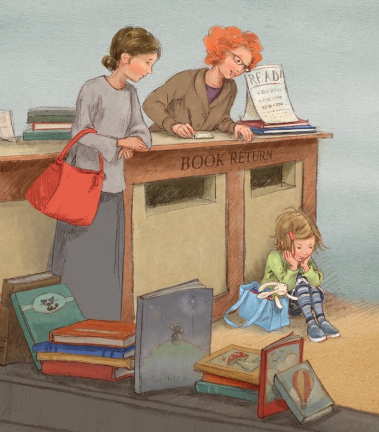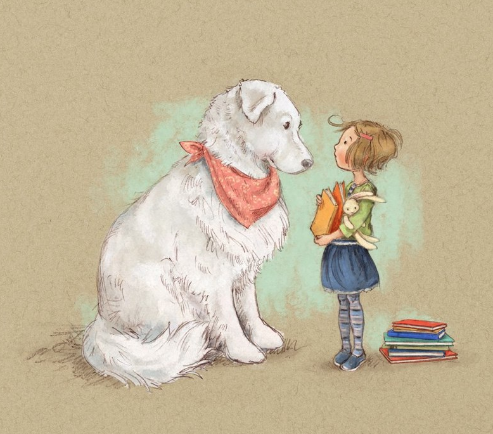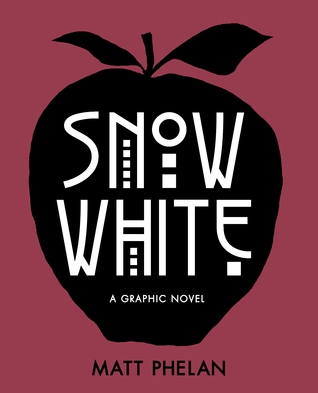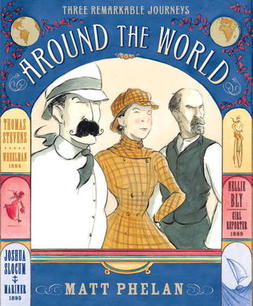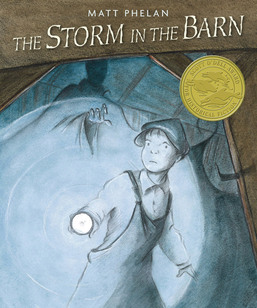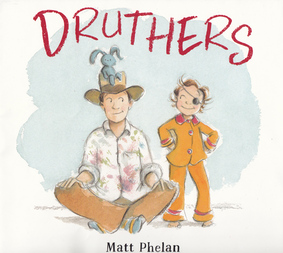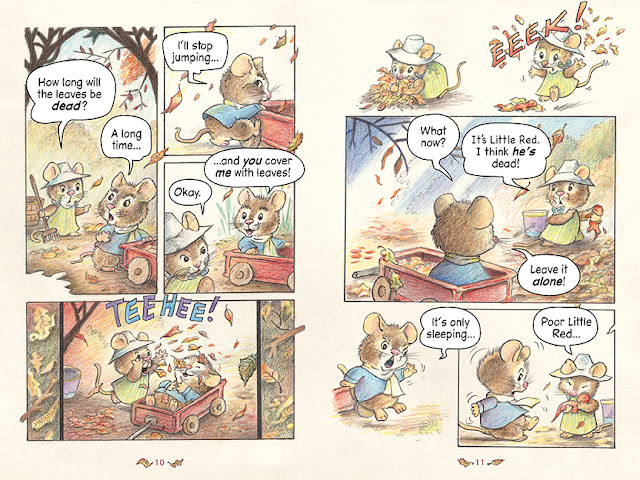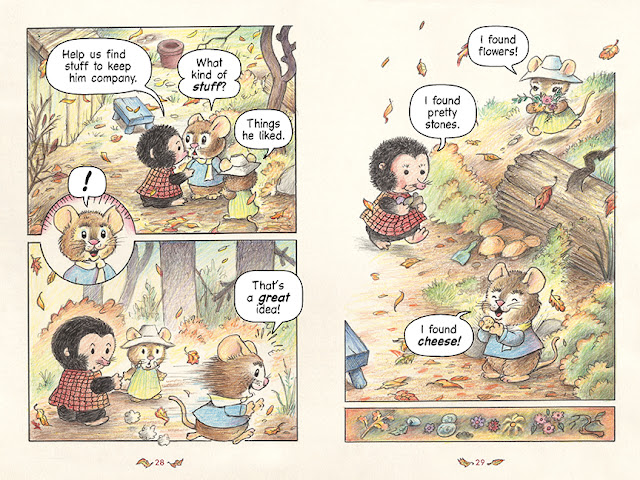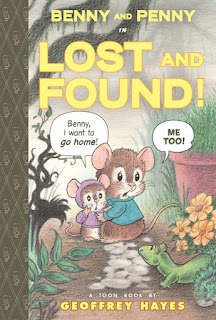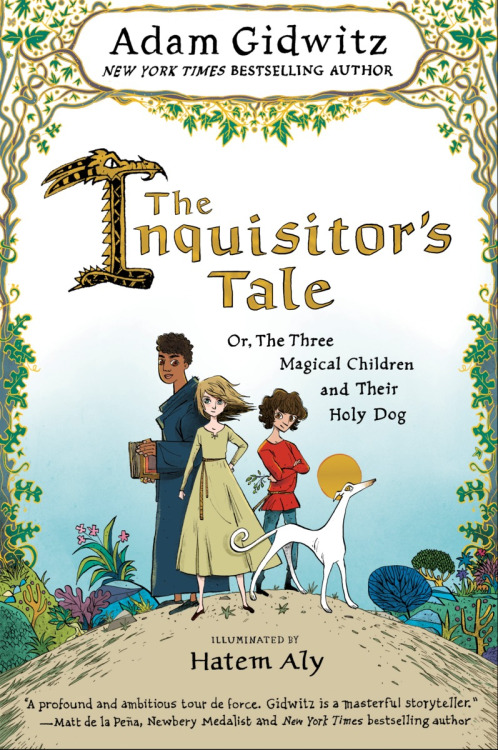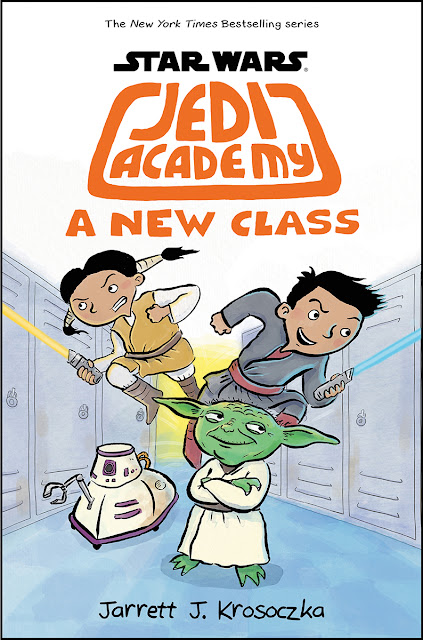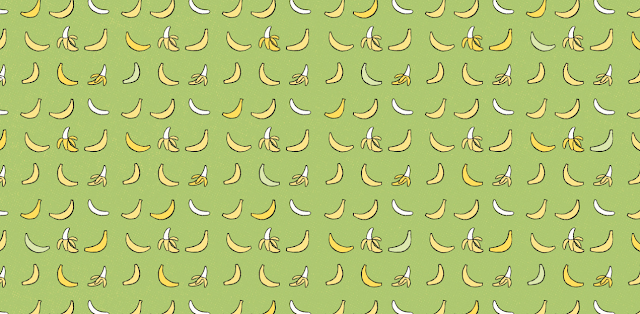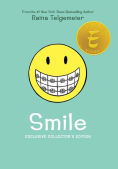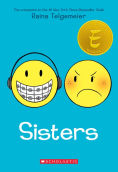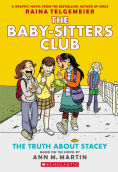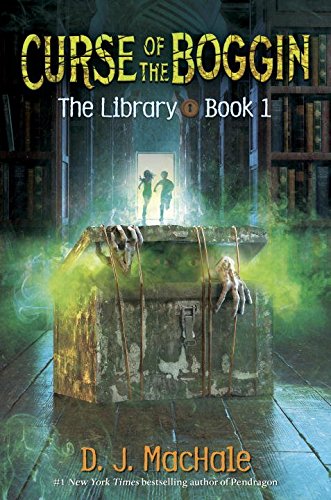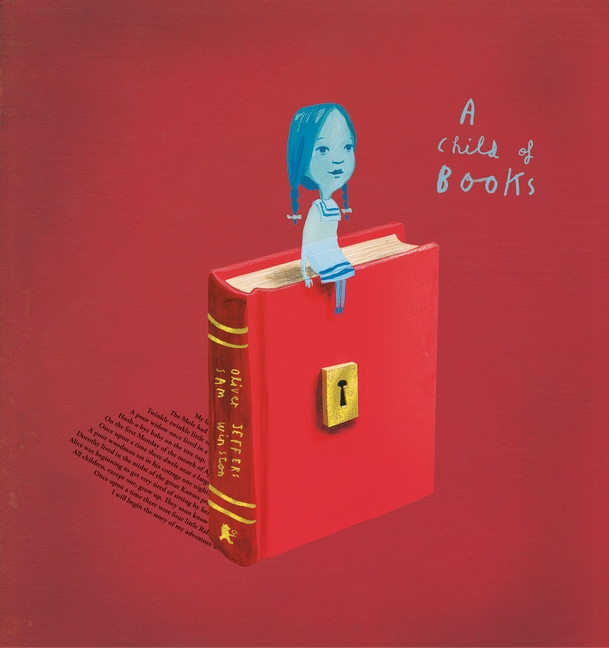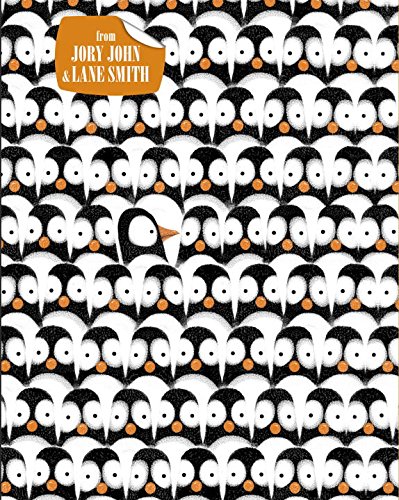new posts in all blogs
Viewing Blog: Children's Book Reviews and Then Some, Most Recent at Top
Results 26 - 50 of 1,820
.jpeg)
As a lover of children's literature, mother and bookseller of 13 years, I want to put good books into kid's hands. I share my philosophy on what makes a book good as well as book reviews and lists of great books for every reading taste and ability with a focus on new readers. I also highlight some wonderful books that are not always on the shelf at bookstores, but might be at your library and can definitely be ordered. All books mentioned are available in paperback unless noted.
Statistics for Children's Book Reviews and Then Some
Number of Readers that added this blog to their MyJacketFlap: 20
Madeline Finn and the Library Dog, written and illustrated by Lisa Papp, is a marvelous picture book that hits a lot of sweet spots for me. But, what first drew me to Papp's book is her illustration style, which reminds me of the wonderful Holly Hobbie. Papp's soft pencil sketches are enhanced by a muted palette and created on paper with visible fibers. She creates an inviting world right away, even in it is a prickly world for Madeline Finn, at first anyway.
Madeline Finn does not like to read. Not books or magazines of "even the menu on the ice cream truck." Decoding is hard for Madeline and she is tired of getting a "Keep Trying" heart sticker instead of a star sticker like everyone else in her class. But things change when Madeline gets a very special opportunity at her public library.
Mrs. Dimple, the librarian, leads Madeline to a room filled with dogs and kids reading to them! She picks Bonnie, a beautiful dog like a "big, snowy polar bear." Soon enough, Madeline is reading to Bonnie, not worrying about her mistakes and feeling better about reading, happy to try those hard words over and over. Just when Madeline is ready to read out loud in class, hoping to get in one more practice session with Bonnie, Bonnie and Mrs. Dimple are not at the library!
America being read to in my library
There is a happy ending for Madeline and Bonnie, one that means there will be even more dogs for kids to read to at the library. Papp tells Madeline's story with a simple sweetness and I love that she has written a book about a real thing - kids practicing reading with dogs! There are more than a few organizations that provide this service, in fact there is even a dog named America that visits my school from time to time to give the kids practice reading and it is a truly magnificent thing to witness.
Source: Review Copy
There is always room for a pirate picture book, especially one like Beth Ferry's Pirate's Perfect Pet, brought to life by the painterly illustrations of Matt Myers. Pirate's Perfect Pet begins with Captain Crave taking a dive off plank of his pirate ship when he spies a bottle with a message in it bobbing near a shark. No problem! Back on board, the Captain unfurls a letter from his Mummy, praising his piratical skills and sharing an article found in Be Your Best Buccaneer magazine. This article just happens to include a checklist to make sure you are living up to your perfect pirate potential as a captain. With the help of his crew, Captain Crave ticks off items on the list, only to discover he is missing a peg leg. And a pet.


Scurrying to set this right, the crew docks in a place that looks quite a bit like Miami Beach. Myers's illustrations are richly detailed and full of laughs. From the beach to the farm to the zoo, Captain Crave just can't find the perfect pet, although he does get his peg leg after a visit with a lion.
 His quest ends in a pet store when something poops in his eye. A parrot with an eye patch and a peg leg? Yep! The pirate's perfect pet.I thought the story could have gone in a different direction, but that's just me. Give the people what they want, and who doesn't want a pirate to have a parrot?
His quest ends in a pet store when something poops in his eye. A parrot with an eye patch and a peg leg? Yep! The pirate's perfect pet.I thought the story could have gone in a different direction, but that's just me. Give the people what they want, and who doesn't want a pirate to have a parrot?
Source: Review Copy
Snow White has always been Matt Phelan's favorite fairy tale. Phelan got the idea to set his version of Snow White in Depression Era New York City while sketching apple peddlers for a story he wrote about Herbert Hoover for the anthology book Our White House. Phelan's illustration lends itself marvelously to the noir tone of this story that is set amidst the end of the Jazz Age and the beginning of the Depression. With the Queen of the Zigfield Follies cast as the wicked stepmother and Detective Prince taking on the role of Charming, the casting is perfect - especially Snow White's protectors and friends, the Seven Dwarves. 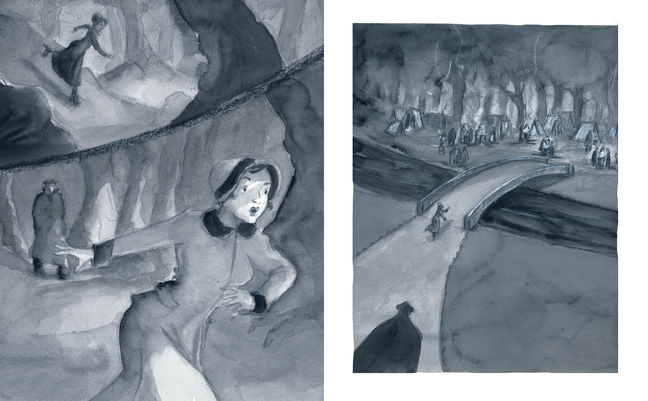
Samantha "Snow" White lost her mother to tuberculosis when she was a little girl. Her father remarries and she is sent to boarding school. Snow's father is a business man and his ticker tape machine, one that he watches with growing unease and concern, especially after surviving the crash. Phelan brilliantly has the ticker tape stand in for the magic mirror that drives the Queen to her wicked deeds. After Snow's father dies, it is his will, naming her as the sole inheritor, not her potential as a rival beauty, that causes her exile. This exile granted to her, instead of death, by Mr. Hunt, a goon with a heart of gold.
 Snow flees to Hooverville where she is rescued by a gang of orphaned boys living on the street. Their relationship is one of my favorite parts of Snow White, with the tough urchins refusing to tell Snow their names, until a tender, heartbrreaking moment later in the tale. I don't want to give away all of Phelan's marvelous adaptations, but I will say that the store window of Macy's does play a special role in this story. Phelan's expressive, suggestive illustrations save the sharp lines for the wicked stepmother's Louise Brook's bob, glaring eyes and her fitting end. Snow and the boys are soft lines and smiles when the world is treating them well, and the ending to Snow White treats them very well and just might bring a tear to your eye. Phelan uses splashes of red sparingly, eloquently and effectively in Snow White, with most of the story playing out in slate greys and occasional icy blues. However, Phelan's "happily ever after" is presented in a warm palette that is indeed a happy ending.
Snow flees to Hooverville where she is rescued by a gang of orphaned boys living on the street. Their relationship is one of my favorite parts of Snow White, with the tough urchins refusing to tell Snow their names, until a tender, heartbrreaking moment later in the tale. I don't want to give away all of Phelan's marvelous adaptations, but I will say that the store window of Macy's does play a special role in this story. Phelan's expressive, suggestive illustrations save the sharp lines for the wicked stepmother's Louise Brook's bob, glaring eyes and her fitting end. Snow and the boys are soft lines and smiles when the world is treating them well, and the ending to Snow White treats them very well and just might bring a tear to your eye. Phelan uses splashes of red sparingly, eloquently and effectively in Snow White, with most of the story playing out in slate greys and occasional icy blues. However, Phelan's "happily ever after" is presented in a warm palette that is indeed a happy ending.
Read my reviews of more of Matt Phelan's graphic novels and picture books here
Source: Review Copy
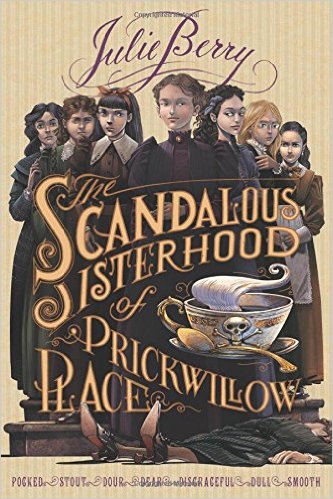
With The Scandalous Sisterhood of Prickwillow Place, Julie Berry creates a masterfully crafted Victorian setting (Berry's author's note at the end of the book is just as entertaining as the book itself) and populates it with intriguing, independent minded young ladies, adding layers of farce and mystery to create a book you won't be able to put down. Set in the cathedral city of Ely, Cambridgeshire in 1890, St. Etheldreda's School for Young Ladies on Prickwillow Road has seven pupils with wonderfully descriptive names. There is Dear Roberta, sent away to school by her jealous new stepmother. Disgraceful Mary Jane is what we would call boy crazy today and has been sent to Ely to keep her from eloping with the wrong kind of boy. Dull Martha and Stout Alice have more to offer than the descriptives they have been labeled with. Smooth Kitty, the child of a business mogul who had been hoping for a male heir, has a mind like a steel trap, if only her father would notice. Pocked Louise was cured of small pox at the age of eight by her uncle, a great surgeon and mentor to her, has been sent to school to discourage her scientific leanings. And, Dour Elinor has an abiding interest in the funereal industry. When Headmistress Plackett and her odious brother Aldous Godding are poisoned during the Sunday meal, each of the seven pupils has a skill that comes into play.
With the daily domestic woman Amanda Barnes off for the Sabbath and just the seven girls in the house, Smooth Kitty puts a plan into action. The girls will run the school and pretend to be Mrs. Plackett, as needed. Of course, they will have to dispose of the bodies of the headmistress and her brother, as well. There are somewhat gruesome moments in The Scandalous Sisterhood of Prickwillow Place, but they are more than outnumbered by hilarious and poignant situations. Of course the girls can't keep up the sham, even if Stout Alice does fit perfectly into Mrs. Plackett's clothes and can imitate her voice, and Berry creates one sticky situation after another, from a raft of guests arriving for a surprise birthday party for Aldous to an elderly neighbor who twists her ankle and insists on spending the night at the school, sharing a bed with the dead Mrs. Plackett. In between these awkward passages, the girls work desperately to figure out who the murderer is, uncovering one curiosity after the next while also dealing with break ins, thefts, a new puppy (unfortunately and comically named Aldous) and the strawberry social, which Alice, acting as Mrs. Plackett, commits to attending.
One of the things I loved most about The Scandalous Sisterhood of Prickwillow Place, besides the characters, setting and story, is the way that things started to fall apart immediately for the sisterhood. Of course seven girls can't run a school and pretend like their headmistress is still alive, even in 1890 when crimes and disappearances were much harder to solve. You know that the girls are going to be found out, but you just read on, hoping that they will find the murderer and maybe even save their school before this happens. Berry wraps up her story marvelously with a very satisfying and much hoped for ending.
Source: Purchased Audio Book
Narrated by Jane Entwhistle
Monsters Go Night-Night by Aaron Zenz may not be the best book to put your little ones to sleep, but it could be the best book to teach them about all the things that we do BEFORE we fall asleep! Zenz has been illustrating and writing picture books and beginning readers since 2008, which is when I started this blog. In fact, Aaron left a comment early on and that is when I learned about his career, his very creative kids and the blogs that they have. A father of six kids, ages (best guess) 6 to 18, Zenz and his kids review their favorite books at Bookie Woogie. Over at Chicken Nugget Lemon Tooty, the Zenz family blog where they share drawings and more, often inspired by kid's books. In fact, the monsters in Monsters Go Night-Night were inspired by drawings Zenz's son made when he was four and five!

The bedtime routine for monsters begins with a snack, moving on to a bath, pajamas, a snuggly companion, tooth brushing, a trip to the bathroom and, of course, kisses goodnight. What makes Monsters Go Night-Night both charming and clever and guaranteed fun for both reader and listener is the guessing game Zenz plays with this routine.
Monsters take baths, but what do they take baths with? Chocolate pudding, naturally! Silly, surprising answers are sure to get laughs. Happily, when we reach the page near the end of the book that reads, "Monsters need to go potty. Where do monsters go?" you will not have to worry about potty training backsliding. Ever the thoughtful parent, a page turn reveals that "Monsters go in the toilet!," with this aside, "Whew! It's a good thing MONSTERS know where to go."
For a very fun peek into the world of a picture book creator, awesome dad and monster lover, be sure to check out this video!
Source: Review Copy
This summer, I discovered that Alexis Deacon, picture book illustrator, author and frequent collaborator with another favorite of mine, Viviane Schwarz, had created Geis, a graphic novel that was already on sale in the UK. I waited patiently for it to go on sale here and, when I finally got to read Geis, I was surprised, enthralled and left breathless by the beauty of the illustrations, the rich world building and the fast pace of the story. I was so sad to read the end of Geis, but, I realized half way into it that it is a trilogy, so there is more to come!

Geis begins with a definition of the word "geis," pronounced "gesh," which is a Gaelic word for a taboo or curse, "like a spell that cannot be broken and certain rules must be obeyed." In an unnamed world that is reminiscent of a Bruegel painting, the Great Chief Matarka is dying without leaving an heir. Fifty people, including the Grand Wizard, the High Priest, the Chief Judge and the Lord Chamberlain have been called to her death bed. Among them is Io, the young daughter of the Kite Lord. Matarka has devised a contest that will determine who will take her place, but Niope, an evil sorceress, using Death Magic, has taken control of the event and tricked the fifty attendees into signing their names to a cursed parchment.


The fifty attendees are hurtled to various corners of the realm by the sorceress and must return to the death chamber to prove their worthiness. Io is the first to return where she learns the horrible truth of the geis from the sorceress. Nemas is next and together, the two know the truth of the challenge the fifty souls face but are not allowed to speak of it. When they do, the curse renders them speechless. They learn that they have until the next sunrise to leave the castle and return for a challenge that will leave all but one of them dead. As Io and Nemas prepare for this battle, we see others facing their fates, some of which are horrific, with bravery and cowardice, together and alone.

Geis is over almost as soon as it starts, yet you reach the final page of this graphic novel feeling like you have been gone for much longer. This is in large part due to Deacon's amazing illustrations and masterful world building. I was reminded immediately of the work of Maurice Sendak, some of which I have shared below. Io proves to be a young but brave and moral hero, struggling to survive in a world that no longer makes sense. I can't wait to see how she faces her next challenge!
Source: Purchased
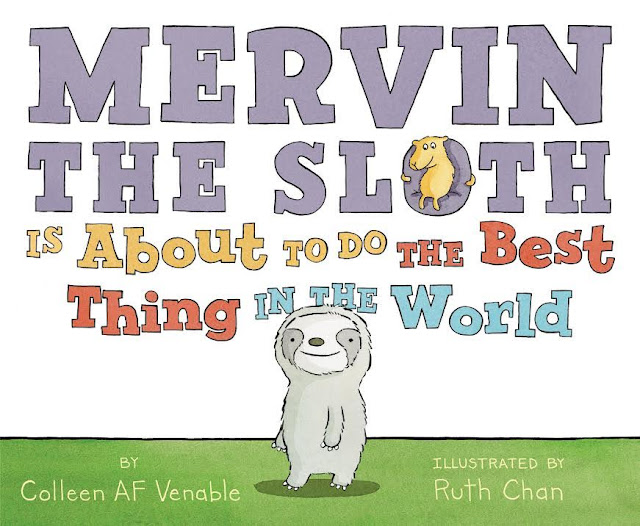
I'm kind of done with meta picture books, but I will never be done with sloths, especially sloths named Mervin. Happily, Mervin the Sloth Is About to Do the Best Thing in the World is a really fantastically fun meta picture book. Colleen AF Venable, graphic novel designer for the excellent FirstSecond by day and graphic novelist by night, makes her picture book debut with the help of illustrator Ruth Chen.
Mervin the Sloth Is About to Do the Best Thing in the World begins with Mervin, center page, slowly moving to the right with each page turn, as the title drops in from the top of the book over the course of a few pages. A red panda, Mervin's friend, strolls onto the scene, taking excited notice of the falling title. More and more friends arrive, all speculating about the best thing in the world that Mervin is about to do. Flying? Digging? Gazelling (which is not even a word, as bird points out)? Is Mervin going to fight a shark? Turn into a robot? Do all our homework? Invent a time machine?
There will definitely be lots of laughs as you read this book out loud, which is a must. Mervin the Sloth Is About to Do the Best Thing in the World should not be read alone and when you get to the end of the book you will see just why...
Be sure to watch this brief video of Colleen and Ruth doing a stellar job reading their book out loud!
Soon to be on the shelves of my school library, Colleen's graphic novel series Guinea PI:





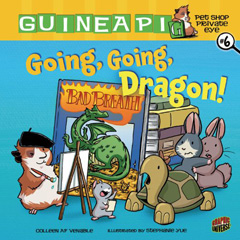
Source: Review Copy
Benny and Penny in How to Say Goodbye is the sixth book featuring these bickering siblings and, as always, Geoffrey Hayes captures the intense and fleeting emotions that young children feel and how they make sense of the world around them perfectly. And, as always, his illustrations are marvelously charming and the natural world that the mice live in gently beautiful. Hayes's graphic novel series is perfect for emerging readers looking for something beyond Frog & Toad and Amelia Bedelia.
In How to Say Goodbye, Hayes has his mice brother and sister encounter death. While playing together in the fall leaves, Penny finds a salamander she named Little Red. She knows that it is dead, having a grasp of what death it. Benny reacts with anger, throwing the salamander into the bushes.
Penny gets help from Melina and the two make plans for Little Red, Benny skulking around the edges of their activities. As the they prepare for the burial, Benny and Penny have memories of Little Red, each feeling their grief in their own ways. They also find ways to honor the life of the salamander. As the story draws to an end, another salamander appears and a new friendship begins.
You can read my reviews of other
Source: Review Copy
In 2010, A Tale Dark and Grimm the debut novel by Adam Gidwitz, captured my attention and that of many other readers, young and old. Gidwitz is a master story teller and his reworking of the fairy tales of the Brothers Grimm, many of them less than well known, is marvelous. I was thrilled when my son shared my enthusiasm for this book and even more excited when I discovered that reading it out loud was a great way to entice my students, many of whom are reluctant and/or struggling readers, to persevere with a longer book. True to his story telling nature, Gidwitz is back with The Inquisitor's Tale, a manuscript illuminated by Hatem Aly and like no other children's book I have read before.
 Set in 1242 and echoing the structure of Chaucer's The Canterbury Tales, The Inquisitor's Tale finds an (initially) unnamed narrator at the Holy Cross-Roads Inn, a day's walk north of Paris. It is the perfect night for a story as a group gathers around the rough wooden table, sticky with ale. The king will be marching past the inn on his way to war with three children and their dog. A brewster, a librarian, a nun, a butcher, a jongleur, a chronicler, a troubadour and the innkeeper take turns telling stories of these three children and their dog, each one adding to the tapestry of their story. Subtly but surely, Gidwizt presents characters who are discriminated against or (much) worse, for gender, religion, and class.
Set in 1242 and echoing the structure of Chaucer's The Canterbury Tales, The Inquisitor's Tale finds an (initially) unnamed narrator at the Holy Cross-Roads Inn, a day's walk north of Paris. It is the perfect night for a story as a group gathers around the rough wooden table, sticky with ale. The king will be marching past the inn on his way to war with three children and their dog. A brewster, a librarian, a nun, a butcher, a jongleur, a chronicler, a troubadour and the innkeeper take turns telling stories of these three children and their dog, each one adding to the tapestry of their story. Subtly but surely, Gidwizt presents characters who are discriminated against or (much) worse, for gender, religion, and class.
 Jeanne is a peasant girl who is seized with visions of the future. As an infant, her parents killed her babysitter/protector, Gwenforte, a white greyhound with a copper blaze on her snout, thinking that the dog had attacked Jeanne. Far from the truth, the loyal Gwenforte had saved the baby from an adder that made its way into the house. Realizing their mistake, they gave the dog a proper burial in a grove that quickly became a holy place and the dog thought of as a saint. Years later, after seeing a beloved neighbor, thought to be a heretic, hauled off by a huge, fat, red headed monk from Bologna, Jeanne knows she must keep her fits and the visions that follow a secret. She must also keep Gwenforte, who has come back to life, a secret.
Jeanne is a peasant girl who is seized with visions of the future. As an infant, her parents killed her babysitter/protector, Gwenforte, a white greyhound with a copper blaze on her snout, thinking that the dog had attacked Jeanne. Far from the truth, the loyal Gwenforte had saved the baby from an adder that made its way into the house. Realizing their mistake, they gave the dog a proper burial in a grove that quickly became a holy place and the dog thought of as a saint. Years later, after seeing a beloved neighbor, thought to be a heretic, hauled off by a huge, fat, red headed monk from Bologna, Jeanne knows she must keep her fits and the visions that follow a secret. She must also keep Gwenforte, who has come back to life, a secret.
 The second child is William, an oblate. The son of a great lord fighting in Spain against the Muslim kings and a Saracen from Northern Africa, he was left at a monastery as a baby. More than his dark color, the size of William is a constant source of amazement and occasional frustration - or worse - to the monks. William's great size, strength and appetite, both for food and knowledge, make him a threat to some of the monks and he is sent away with a donkey, saddlebags full of books to be delivered to another monastery by way of a forest inhabited by fiends.
The second child is William, an oblate. The son of a great lord fighting in Spain against the Muslim kings and a Saracen from Northern Africa, he was left at a monastery as a baby. More than his dark color, the size of William is a constant source of amazement and occasional frustration - or worse - to the monks. William's great size, strength and appetite, both for food and knowledge, make him a threat to some of the monks and he is sent away with a donkey, saddlebags full of books to be delivered to another monastery by way of a forest inhabited by fiends.
 Finally, there is Jacob, a Jew who survives the burning of his village by Christian boys and has the ability to miraculously heal the sick and injured. Jacob only wants to be reunited with his parents, but his ability to read and his love of his religion shape his path. As The Inquisitor's Tale unfolds, it becomes clear that, not only is this a story about stories and storytelling, it is a story about books. There are many strange twists and turns in The Inquisitor's Tale, including a hilarious incident with a dragon who, by way of a lactose intolerance issue, comes to pass gas that sets knights on fire. This leads to a fantastic scene with a cure from Jacob that involves vomiting up a tremendous amount of French cheese, Époisses, which Jeanne describes as tasting like life, "Rotten and strange and rich and way, way too strong." As the tales are told, we come to learn that King Louis is planning a book burning that the children will inevitably be part of. In fact, he has had his monks gather up all the texts written in Hebrew and created an enormous bonfire in the heart of Paris. Being an oblate, William has a deep reverence for books, knowing the time and effort that goes into copying out a text. Being Jewish and able to read, Jacob also has a great reverence for books and the word of the Talmud. It is this reverence for books that leads the three children and Gwenforte to an amazing standoff with the king and his terrible mother at Mont Saint-Michel, the incredible island commune in Normandy.
Finally, there is Jacob, a Jew who survives the burning of his village by Christian boys and has the ability to miraculously heal the sick and injured. Jacob only wants to be reunited with his parents, but his ability to read and his love of his religion shape his path. As The Inquisitor's Tale unfolds, it becomes clear that, not only is this a story about stories and storytelling, it is a story about books. There are many strange twists and turns in The Inquisitor's Tale, including a hilarious incident with a dragon who, by way of a lactose intolerance issue, comes to pass gas that sets knights on fire. This leads to a fantastic scene with a cure from Jacob that involves vomiting up a tremendous amount of French cheese, Époisses, which Jeanne describes as tasting like life, "Rotten and strange and rich and way, way too strong." As the tales are told, we come to learn that King Louis is planning a book burning that the children will inevitably be part of. In fact, he has had his monks gather up all the texts written in Hebrew and created an enormous bonfire in the heart of Paris. Being an oblate, William has a deep reverence for books, knowing the time and effort that goes into copying out a text. Being Jewish and able to read, Jacob also has a great reverence for books and the word of the Talmud. It is this reverence for books that leads the three children and Gwenforte to an amazing standoff with the king and his terrible mother at Mont Saint-Michel, the incredible island commune in Normandy.
While The Inquisitor's Tale has a deep vein of Christian thought and history running through it, Gidwitz makes his story richer and more engaging by also highlighting those who suffered in the face of Christianity. He begins the book, which he researched for six years and includes an extensive and interesting author's note as well as an annotated bibliography, with a quote from poet W. H. Auden that calls for loving "your crooked neighbor / With your crooked heart." It is this thought, one that Jacob reads in the Talmud and Jeanne notes that Jesus said, but in reverse, that drives the story and the children. As their adventures escalate and they meet many broken, crooked, questionable adults (they are the only children in the story) and they forgive and love their neighbors over and over. When they find themselves discussing Cain, Abel and the use of the word "bloods" (and not "blood," which William attributes to drunk scribes) they compare the loss of one life, which is really the loss of many - the descendants that person may never have - to the loss of books and the knowledge they contain and can eventually touch many lives with, Willam saying,
A scribe might copy out a single book for years. An illuminator would then take it and work on it for longer still. Not to mention the tanner who made the parchment, and the bookbinder who stitched the book together, and the librarian who worked to get the book for the library and keep it safe from mold and thieves and clumsy monks with ink pots and dirty hands. And some books have authors, too, like Saint Augustine or Rabbi Yehuda. When you think about it, each book it a lot of lives. Dozens and dozens of them.
To this, Jeanne adds, "Dozens and dozens of lives, and each life a whole world." Having worked in almost all aspects of the world of kid's books at this point in my working life, I feel compelled to add to this idea. It is truly amazing, even in this day when books are printed by machines and illustrations can be created on computers, to realize how many hands touch a written work before it becomes a book on a shelf, from the literary agent (and the agent's assistant) to the editor at the publishing house to the booksellers, reviewers and librarians who embrace the story and pass it on, retelling it to invite new readers. And that's not even mentioning the writer's critique groups and family and friends who read manuscripts in the early (and late) stages. Storytelling touches us all, whether we write the words or not, and I am grateful to Adam Gidwitz for reminding us of this - especially with such a highly entertainingly readable book like The Inquisitor's Tale!
source: review copy

Jeffrey Brown authored the first three books in the Jedi Academy series, two of which I enthusiastically reviewed here. This trilogy is HUGELY popular in my school library and a fantastic alternative to Diary of a Wimpy Kid. Before that, Brown wrote a trilogy of Darth Vader, a comics series that imagines Vader's life as father to Luke and Leia. Brown's new series debuted in August and features prehistoric siblings Lucy and Andy as they deal with typical kid stuff while also being filled with scientific information and facts about pre-history.
Jedi Academy was too good to let go, and quite smartly, Scholastic has tapped Jarrett Krosoczka, author of the Lunch Lady series of graphic novels. Jedi Academy: A New Class finds young Victor Starspeeder making a midyear transfer from the Jedi Academy at Obroa-skai, where he has had a series of mishaps to the Jedi Academy at Coruscant. Victor decides that he is going to start keeping a journal of his time at Jedi Academy because that is what his father, who died when Victor was a baby, did. 
The Jedi Academy has its own challenges, starting with Christina, Victor's big sister, who already goes there. She tells him in no uncertain terms that once they are at school, they are strangers. Navigating the new school on his own, Victor is swayed by Zach, and older student, who turns out to be a bully and a prankster with his own agenda. He also gets stuck with Artemis, an asthmatic kid in a black hooded cloak who just might be a Sith. Victor tries to make friends, impress a girl, and get his special project on the planet Endor completed while also trying to stay out of trouble and keep Zach from getting him kicked out.

Krosoczka hits all the right notes in Jedi Academy: A New Class, continuing and updating features that Brown introduced in the first three books like handwritten notes between characters, school schedules and pages from the school newspaper, including an advice column by Ms. Catara, the school guidance counselor who is also a Gungan. Krosoczka also creates a couple new twists, including the Galaxy Feed, which is a social media type feature that pops up on a tablet like device, and a page of comic strips that look at classics like Family Circus, Peanuts and Garfield through the lens of Star Wars. I especially liked, "Huttfield," in which Jaba the Hutt is the lazy, food loving star of the strip.
While I love that this series continues on (and I hope that, after another three books a new author/illustrator takes on this challenge) and am thrilled that I have more of these books to offer students, for me, Krosoczka's take on the academic world of the young Jedi lacks a bit of the depth, heart and humor that I found in Brown's books. But hey, I'm pretty sure I'm not the target audience for these books...
Source: Purchased
Ape and Armadillo Take Over the World by James Sturm is my new favorite book. I fell in love with TOON Books when I discovered them in 2008, just around the time my youngest was learning to read. Having been through this process with my two older children, I was not looking forward to the tired old leveled readers that we were left to slog through after classics like Frog & Toad, Little Bear and Poppleton. Françoise Mouly and her quest to bring engaging, marvelously illustrated graphic novels into the world of beginning readers has meant that there are now over 50 fantastic books to take your new reader from sight words to chapter books.

If you have read even a few beginning readers, you know that unlikely friends and the complexities of friendship are the staple of this genre. With Ape and Armadillo, Sturm has created the only duo who could even remotely rival Frog and Toad. And an armadillo! How many armadillo characters are there in kid's books to begin with? Happily, the title page shows Ape juggling, a curled up Armadillo among the balls in the air. Sturm's illustrations are superb - crisp and colorful and filled with motion and emotion.

Armadillo is a little guy with big ideas. Ape, his opposite, is more thoughtful and compassionate. When Ape and Armadillo Take Over the World begins, we find Ape taking issue with Armadillo's plan for world domination. While Armadillo does things fly away on the royal Pegasus, Ape has to distract a spitting serpent, fight an army of robots and escape through the sewer tunnels of the castle. Armadillo counters, saying that he is the one who thought up this plan and having ideas is not so easy. When Ape tries to come up with a plan (that involves kids, an ice cream shop, juggling Armadillo and hiding in tubs of ice cream) Armadillo shoots him down. But, like all good friends, the two manage to find common ground, coming up with a phenomenal plan for world domination that involves special suits, magic wands, creating a zoo filled only with really cool animals like griffins, dinosaurs and giant bugs and ending with ice cream. Because, as Ape points out, he likes a lot of the people in the world and doesn't want to rule it or blow it up.

The best part of Ape and Armadillo Take Over the World? Sturm includes bonus comic strips that run at the bottom of every page, giving readers a glimpse into the personalities of the main characters. Ape and Armadillo embody the creative imagination of kids, a creativity that is not bound by logic or physical limitations.
Read my reviews of the Adventures in Cartooning Series here
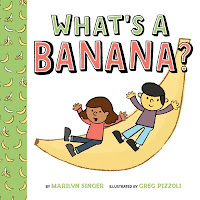

Marilyn Singer, author of many wonderful picture books and books of poetry for children, and Greg Pizzoli, superb illustrator and author of picture books and non-fiction picture books, have teamed up for two books that are perfect for toddlers and emerging readers. What's a Banana? and What's an Apple? combine Singer's silly, sing-song-y rhymes with Pizzoli's playfully silly illustrations for two very fun books.
Singer begins What's a Banana? like a playground chant, "You can grip it and unzip it. You can mash it with a spoon. You can trace it. Outer-space it - make believe that its' the moon." Pizzoli's illustrations show a boy, a girl, a dog and a cat, doing all these things with a banana, which is sometimes actual size and more often oversized, adding to the silliness. What's a Banana? wraps up with a reminder not to forget that it's a fruit.What's an Apple? follows a similar path, although focuses a bit more on this versatile ingredient, reminding readers in words and pictures that you can juice it, peel it, bake it and, "caramel it." What's an Apple?, which also features a different boy and girl and the same cat and dog, ends with the kids in space suits on the moon, about to enjoy and apple "any place."The trim size of What's a Banana? and What's an Apple? are small and square, a bit bigger than a board book. Perfect for little hands, but definitely for readers who know how to handle a book. I hope that Singer and Pizzoli have more foods to explore...

The Cranky Ballerina by Elise Gravel is a picture book for both kids AND parents. I am not a helicopter parent by any stretch of the imagination and my kids are not over-scheduled. That said, I have signed them up for various classes and worried that they weren't getting the most out of them as they whined about having to go or, even worse (and predictably) complained about having to practice. Then I worried that I was forcing them to do something that I thought was important but would never be important to them. Then I worried that they would reach adulthood without realizing their creative or athletic potential (why did my mother let me quit piano lessons? And guitar lessons??) and maybe miss out on a scholarship or two. For me, reading The Cranky Ballerina was a huge catharsis. Maybe I am reading too much into Gravel's delightfully charming book, maybe I am just carrying a ton of parental guilt around with me. Either way, The Cranky Ballerina is a fantastic read, whoever you are, whatever lessons you took and whatever lessons your parents let you quit or you let your kids quit...
 It's Saturday and Ada wakes up cranky. She hates everything, from her too-tight leotard to her itchy tutu to the car ride. Ada hates ballet. She hates to practice and her pirouettes are nearly catastrophic. Fourth position sends her swirling into the hall where she head butts a guy dressed in "some kind of pajamas" who asks, "Do you think you could do that again for my class?"
It's Saturday and Ada wakes up cranky. She hates everything, from her too-tight leotard to her itchy tutu to the car ride. Ada hates ballet. She hates to practice and her pirouettes are nearly catastrophic. Fourth position sends her swirling into the hall where she head butts a guy dressed in "some kind of pajamas" who asks, "Do you think you could do that again for my class?"
Turns out that guy in weird pajamas is a karate instructor and Ada has all the right moves for his class! "Front kick! Swoosh! Side Punch! Roundhouse kick! Swat!" Ada learns something new and feels something new - a smile spreads across her face as she feels, for the first time, successful at something. The penultimate page of The Cranky Ballerina shows Ada, in her tutu, practicing with the class. The final page turn show a classmate in his ghee thinking, "I hate karate."
Genius! Brilliant! I am in love with Elise Gravel's books and can't wait to see what she does next!
Source: Review Copy
BLIP! by Barnaby Richards is a fantastic new TOON Book at the essential Level 1. Featuring a robot, I was drawn to BLIP! immediately. The story begins on the endpapers as we a spaceship floating through the galaxy. "Blip," goes the ship. Until it goes, "Tchok!" when it hits a mountain on a planet.
The robot climbs out of his his ship and begins to explore, always saying, "Blip," sometimes as statement, an exclamation or even a question. Richards's planet is a strange one, filled with curious details that you will want to spend time with. The robot goes over land and under water, meeting all kinds of creatures, even a human.
Finally, the robot returns to the ship only to find another robot working on another ship! The two exchange "blips" and "bleeps" and head off, back into space.
Blip! is a fantastic introduction to the sequential art of the graphic novel and it is also (as are all the books TOON publishes) a superb example of what founder François Mouly started out to do in 2008 - created beginning readers with engaging illustrations and stories that are anything but boring.
Source: Review Copy
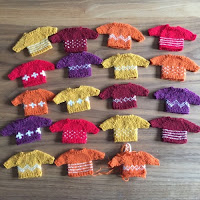 Vera Brosgol, Russian born author of the superb graphic novel Anya's Ghost, has written and illustrated her first picture book and it is brilliant! Leave Me Alone! reads like an Eastern European folk tale with a surprise center. As the jacket flap reads, it is an "epic tale about one grandmother, a giant sack of yarn, and her quest to finish her knitting." A knitter herself, Brosgol created these 25 tiny sweaters as give-aways to promote Leave Me Alone!
Vera Brosgol, Russian born author of the superb graphic novel Anya's Ghost, has written and illustrated her first picture book and it is brilliant! Leave Me Alone! reads like an Eastern European folk tale with a surprise center. As the jacket flap reads, it is an "epic tale about one grandmother, a giant sack of yarn, and her quest to finish her knitting." A knitter herself, Brosgol created these 25 tiny sweaters as give-aways to promote Leave Me Alone!
Leave Me Alone! begins, "Once there was an old woman. She lived in a small village in a small house . . . with a very big family." Winter is coming and this grandmother needs to get her knitting done but no one will let her. At the end of her rope, the old woman gives the house a cleaning from top to bottom, packs up her things in a large sack and leaves the house shouting, "Leave me alone!"
 It turns out that, every where she goes, her balls of yarn are an endless source of fascination to all creatures around her. From bears to mountain goats, she just can't get a break. She climbs up a mountain at night, going so high that, when she reaches the top she keeps climbing - right onto the moon. A page turn takes Leave Me Alone! from folk tale to sci-fi mash-up. It turns out little green moon-men are fascinated by balls of yarn, too.
It turns out that, every where she goes, her balls of yarn are an endless source of fascination to all creatures around her. From bears to mountain goats, she just can't get a break. She climbs up a mountain at night, going so high that, when she reaches the top she keeps climbing - right onto the moon. A page turn takes Leave Me Alone! from folk tale to sci-fi mash-up. It turns out little green moon-men are fascinated by balls of yarn, too.
 Finally, a wormhole provides the quietude needed to get that knitting done. The old woman was, "absolutely, completely utterly alone. It was PERFECT." When thirty little sweaters are finally knit, she tidies up, sweeping "the void until it was a nice, matte black." She has a cup of tea from her samovar and walks back through the wormhole where "everything was right where she'd left it." The juxtaposition of the story and the illustrations, with their Eastern European feel and the outer space elements is marvelous! I can't wait to see what Vera Brosgol does next - in picture books and graphic novels! Actually, I just happen to know (because I read it in an interview she did with Bustle) that Be Prepared, Brosgol's middle grade graphic novel memoir about a summer she spent at a Russian Orthodox camp in upstate New York, will be released in the Spring of 2018!
Finally, a wormhole provides the quietude needed to get that knitting done. The old woman was, "absolutely, completely utterly alone. It was PERFECT." When thirty little sweaters are finally knit, she tidies up, sweeping "the void until it was a nice, matte black." She has a cup of tea from her samovar and walks back through the wormhole where "everything was right where she'd left it." The juxtaposition of the story and the illustrations, with their Eastern European feel and the outer space elements is marvelous! I can't wait to see what Vera Brosgol does next - in picture books and graphic novels! Actually, I just happen to know (because I read it in an interview she did with Bustle) that Be Prepared, Brosgol's middle grade graphic novel memoir about a summer she spent at a Russian Orthodox camp in upstate New York, will be released in the Spring of 2018!
Brosgol also created these adorable paintings of the children from Leave Me Alone! to promote the book!
Also by Vera Brosgol:
Source: Purchased
I love verse novels and, with every review I write of one I search for the perfect analogy to describe the experience of reading one and continue to fall short, but will try one more time. This summer, my older son and I became obsessed with green tea mochi. These sweet, fragrantly floral little treats can be eaten in two (or even one) bites and pack immense but delicate flavor, leaving you feeling like you have eaten a much bigger desert. Reading a verse novel, I am always amazed at the ability of an author to tell a richly vivid story with deftly drawn characters and an engaging chain of events with less than half the words used in a traditional novel. I can read a verse novel in one or two bites - I mean one or two sittings - and come away feeling like I have eaten, I mean read, a larger, longer, bigger work.
MOO by Sharon Creech is the fourth verse novel I have reviewed by this multiple award winning author and possibly my favorite. In each of her verse novels, which often uses concrete poems to emphasize an emotion or experience of one of the characters, Creech's characters deal with losses and MOO is no different. Twelve-year-old Reena and her seven-year-old brother Luke are uprooted when their parents, in the wake of a job loss, decide to move from New York City to a small town in Maine. When their mother, a reporter who has made a career of talking to strangers, volunteers the two to help out their new neighbor, it seems like she has made a huge mistake. Their elderly neighbor Mrs. Falala is strange. She has a long grey braid, a curious collection of animals (including a snake named Edna) and a curt manner that scares Luke the first time they meet at her house on Twitch Street.
While afternoons with Mrs. Falala are dark, the siblings enjoy the freedom of living in a small town, riding their bikes and watching the cows on the nearby dairy farm where they befriend Beat and Zep, two teens who work on the farm and educate them about the belted Galloway cows there. Soon, Reena is finding her way around Mrs. Falala's menagerie, including Zora, a formerly prize winning belted Galloway with a bad attitude as big as she is. Zep and Beat give Reena tips on how to win over Zora and prepare her to be shown at the fair while Luke seems to be winning over Mrs. Falala by teaching her to draw.
A happy day for Reena and Luke ends with sadness, but a silver lining emerges. The passage at the end of MOO where the children walk through Mrs. Falala's home, discovering a hallway filled with her drawings, showing her progression as an artist, will stay with me always. Once again, Creech has written a novel that is filled with emotions and experiences, ups and downs, that are unexpectedly marvelous. Who would have thought that a novel that beings with an ornery, slobbering, filthy cow named Zora would lead to such a beautiful, memorable story?
Verse Novels by Sharon Creech
Source: Review Copy
Leigh Hodgkinson's picture books burst with energy, creativity and cleverness and The Big Monster Snorey Book, filled with colorfully crazy, not too scary looking monsters, does not disappoint.
At first, The Big Monster Snorey Book seems like a very noisy tour of monster land at night with a curious little journalist. Each monster has a different issue, be it "terribly tatty toenails" that make a lot of noise or monsters who "jibber-jabber and bibble-babble in their sleep."


As the little monster makes his way past the sleeping monsters, he's doing more than being a tour guide. Sharp eyes will notice that he is collecting items as he goes along, recording the nighttime sounds of his fellow monsters. But WHY he is doing this is not revealed until an alarm clock goes off, all the monsters wake up and we discover that, "after a snooze, monsters are alawys VERY hungry" and will start looking for little monsters to eat. From his hiding place, his recorder blaring out the sleep sounds he recorded, the little monster watched them flee, saying, "Hee, hee! I love it when a plan comes together!" The final page puts it all in place as we see the little monster, safe down a hole, sleeping soundly with his recorder and all the things he gathered along the way.
More books by Leigh Hodgkinson!
Goldilocks and Just the One Bear
Source: Review Copy
I don't think I can put into words how much I love The Creepy Case Files of Margo Maloo by Drew Weing. Not only is Margo just about the coolest girl detective I have encountered in quite a while, she is kind of a ghostbuster. More accurately, Margo Maloo keeps the peace between the world of the humans and the hidden world of monsters in Echo City. Best of all, The Creepy Case Files of Margo Maloo started as a web comic and continues on line where you can read new chapters! The Creepy Case Files of Margo Maloo begins with Charles Thompson's move from a small town to the big city, a move he's not happy about. The Thompsons are moving into the Bellwether, a former hotel built in 1925 with authentic Art Deco fixtures. Along with a few other residents, they will get to live there for free while Charles's dad fixes the place up. Charles, not much of an outdoors kind of kid, fancies himself a budding journalist and writes a blog.
Charles meets Kevin, a neighbor who is trying to break a world record, any world record. Kevin tells Charles like where the best candy store in the neighborhood is and what to do if anything weird is going on in your apartment. It just so happens that, the night before, a huge monster crept out of the closet after Charles turned off the lights. Kevin hands him the business card of Margo Maloo, monster mediator, and the adventure begins.

Drew Weing brings a fantastic sense of humor, a marvelous eye for detail and a brilliant talent for world building to The Creepy Case Files of Margo Maloo. She and Charles head to the lair of a local troll named Marcus who collects Battlebeanz, specifically the Big Cat set. In one of Weing's superb details, he creates names for many of the Big Cats like "Dread-Lion," "Fight-Mare" and "Ty-Gore," and Marcus and Charles have a fast paced conversation about them. Another great scene comes at Ms. Koff's store, a grocery store for monsters hidden under a Quickmart. Weing's illustrations for these scenes are dark and creepy and filled with things you will pore over again and again.

Once he gets over his initial fear, Charles is hooked and wants to tag along with Margo, even suggesting he become her partner after he helps her find a missing ogre baby with a serious sweet tooth (yet another chapter with great twists, this one involving a kidnapper who wears a baseball cap and takes notes all the time but is not Charles...) In the end, Charles settles for assistant when Margo tells him he knows too much. She either has to put him to good use of have him "' accidentally' run into a pack of hungry ghouls."
Best of all, Weing's layered story ends with a few pages from an encyclopedia of monsters with Margo's notes in the margins! Which reminds me, another super cool think about The Creepy Case Files of Margo Maloo is the trim size of the book, which is exactly like a slightly oversized reporter's notebook! I can't wait for the next installment of creepy case files!
Source: Review Copy
Five years ago I reviewed my first book by Ben Hatke and I was immediately hooked. You can read my reviews of all of his books here. After a couple of picture books and a mostly wordless graphic novel, I am very excited to be reviewing the first in a new trilogy, Mighty Jack, a play on the old fairy tale with a garden full of enormous plants and some serious sword play. And, as always, you can expect strong girl characters who share equal page time with the titular Jack.
Hatke is a gifted visual story teller and Mighty Jack is driven by the illustrations with spare but meaningful dialogue, including lots of great onomatopoetic expressions. He begins the his story with Jack being awakened from a dream. His mother is out the door, on the way to the flea market. Past due bills can be seen on the counter as Jack grabs breakfast to go. In the car, she explains that she is going to work two jobs this summer and will need Jack to help more with Maddy, his younger sister who is on the spectrum. At the flea market (where fans of Hatke's will spot characters from past graphic novels), Jack's mother gives him money to buy food and the keys to the car in case Maddy needs to get away from the crowds. But when the non-verbal Maddy speaks, emphatically telling Jack that he has to make a deal with the suspiciously friendly man sitting behind a table with a sign that says, "Just Stuff," Jack makes a deal - his mom's car for an ornate wooden box filled with packets of seeds.


Maddy is up and early the next day, planting a garden. Jack helps, happy to see her busily at work, but also apprehensive. What grows from the seeds is both amazing and frightening and Jack is not sure how to handle it, especially since Maddy is so attached to the garden. Happily, a homeschooled neighbor who is also a fencer, stops by. Lilly is soon helping Jack and Maddy while also pocketing seeds and cuttings as she goes. Hatke's marvelous imagination blooms in Maddy's garden, from adorable little onion-headed babies to menacing melons with vine-y legs. The presence of Wormweed, eradicated from earth for thousands of years, even calls forth a dragon from another realm. Jack, Maddy and Lilly even begin to sample the fruits of the garden, reveling in the magical powers each plant gives them. Eventually, though, Maddy is injured and Jack discovers a plant that drives him to destroy the garden.
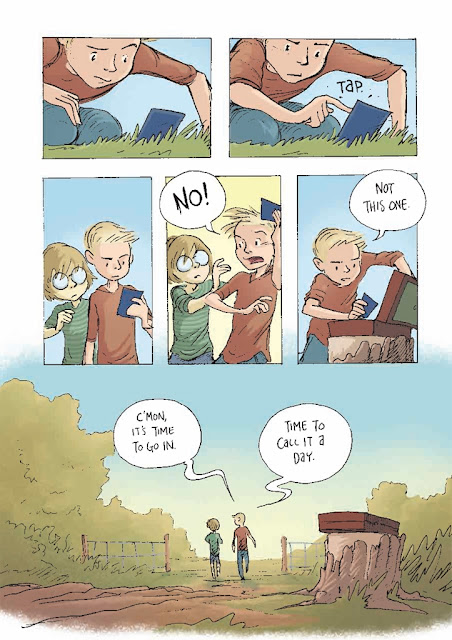
Thinking that the adventure is over, Jack discovers that both Maddy and Lilly have been keeping secrets and a new adventure begins. This time, though, Jack is well equipped with fencing gear and an equally brave and strong partner at his side.
Ben Hatke, fencing!
Source: Review Copy

In 2010, Raina Telgemeier was my introduction to graphic novels. As a bookseller, I was aware of the section with graphic novels for adults and, for the most part they seemed like bleak, dark stories filled with superheroes. Upon seeing Telgemeier's book on the shelf in the kid's section, I was drawn to the mint green cover with the bright yellow, braces filled smiley face of Smile. While I was a bit suspicious, thinking this might be a more superficial story about the awkwardness of braces, I was hooked immediately when I read the first few pages, learning real, autobiographical story behind the braces. Since that day, I have eagerly awaited, read and reviewed all of Telgemeier's books (except Sisters, for some reason) and you can read those reviews here. When I became an elementary school librarian two years ago, one of my first missions was to create a graphic novel section. The shelves currently hold (when they are not checked out, which they always are) ten copies of Smile and Sisters, three copies of Drama and four sets of the four The Babysitter's Club graphic novels, including one set in the newly colored editions. And, once I get my book budget for the year, there will be five library bound copies of Ghosts sitting beside the three paperback copies I bought out of pocket.
Raina Telgemeier has a gift for creating immediately accessible characters who are as colorful and full of life as her vivid illustrations. She also is exceptionally talented at presenting families that, while they have their struggles and conflicts, are connected, supportive, loving and thoughtful. With Ghosts, Telgemeier adds a new layer to her storytelling in the character of Maya, younger sister of main Catrina, who suffers from the degenerative condition, cystic fibrosis. Maya's illness is what causes the family to move from Southern California to the small seaside town in Northern California, Bahía de la Luna. As a native Californian, I love that Telgemeier sets some of her stories here and was so excited to learn that the town of Half Moon Bay was the inspiration for the setting of Ghosts. I also got a kick out of her version of In & Out Burger, a chain restaurant that is only in Southern California.
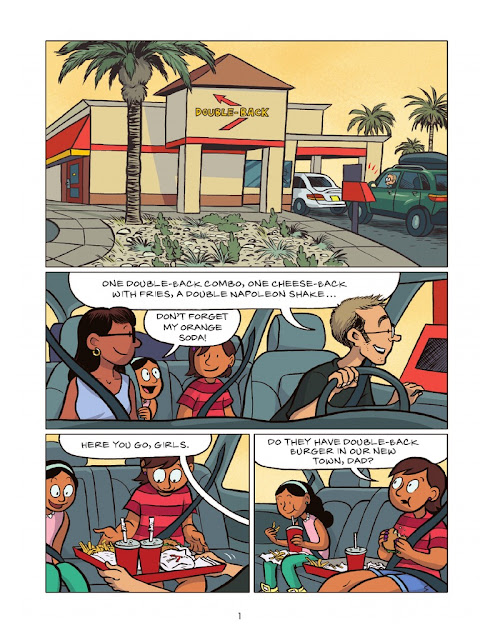
Telgemeier introduces and balances many themes skillfully in Ghosts. There are sibling issues, like Maya's illness and how Cat lovingly protects her but also wants a life of her own, separate from Maya. Then there are family issues that arise as they settle into Bahía de la Luna, which has a large Mexican American population. When the girls learn about Día de los Muertos, the Day of the Dead, which is celebrated with a huge festival and midnight party in Bahía de la Luna, Maya questions her mother about her childhood as a second generation Mexican American. And, with Ghosts, Telgemeier introduces magical realism into her story telling. Carlos Calaveras, neighbor and classmate of Cat's, works as a guide, giving tours of the ghosts of Bahía de la Luna. Cat is suspicious, then furious after she sees that Maya is enthralled with the idea of ghosts and take chances with her health to see one.
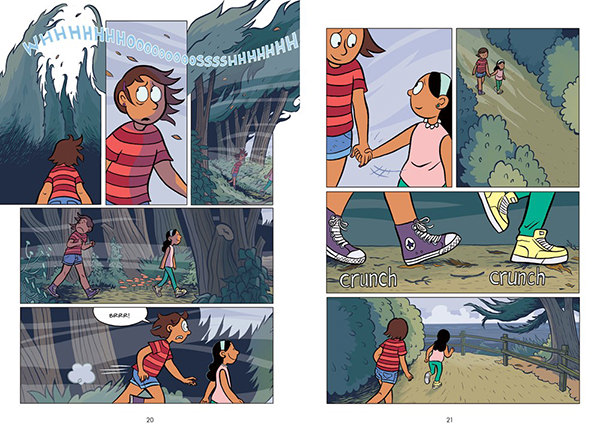
 Cat tries to humor Maya and her excitement over meeting a ghost, but their expedition ultimately puts her in the hospital. Cat spends the rest of the novel coping with her guilt, making new friends, being angry at Carlos and worrying about Maya. Telgemeier ends Ghosts with the marvelous Halloween night, which flows into to the Día de los Muertos celebration where Cat has a change of heart that allows her to make connections with the abuela she never knew, forgive Carlos and make Maya's wish come true.
Cat tries to humor Maya and her excitement over meeting a ghost, but their expedition ultimately puts her in the hospital. Cat spends the rest of the novel coping with her guilt, making new friends, being angry at Carlos and worrying about Maya. Telgemeier ends Ghosts with the marvelous Halloween night, which flows into to the Día de los Muertos celebration where Cat has a change of heart that allows her to make connections with the abuela she never knew, forgive Carlos and make Maya's wish come true.
This is a fantastic trailer that captures the magic of Ghosts!
Raina Telgemeier's books:
 I have been a huge fan Amy Ignatow's superior notebook novel series The Popularity Papers since reviewing the first book back in 2010. And, Ignatow's is the only series where I have reviewed every single book as it is published. I definitely have favorite trilogies and series that I keep up with but rarely have the time to continue reviewing the books as they are published. I felt so passionately about the marvelous characters and storylines in Ignatow's series about two best friends navigating the rough waters of middle school that, with each new release in this seven book series, I wanted readers to know about it - and I also wanted to talk about each book. If you aren't familiar with this series, I hope you will seek it out, either before or after you read the first book in Ignatow's new series, The Mighty Odds!
I have been a huge fan Amy Ignatow's superior notebook novel series The Popularity Papers since reviewing the first book back in 2010. And, Ignatow's is the only series where I have reviewed every single book as it is published. I definitely have favorite trilogies and series that I keep up with but rarely have the time to continue reviewing the books as they are published. I felt so passionately about the marvelous characters and storylines in Ignatow's series about two best friends navigating the rough waters of middle school that, with each new release in this seven book series, I wanted readers to know about it - and I also wanted to talk about each book. If you aren't familiar with this series, I hope you will seek it out, either before or after you read the first book in Ignatow's new series, The Mighty Odds!
 With The Mighty Odds, Ignatow is back and better than ever! Doing what she does best, Ignatow has created a compelling cast of very diverse characters in this novel that is filled with fantastic illustrations and full page comics, giving readers first person glimpses into their minds. In The Mighty Odds, there are the popular kids and the weirdos, the bullies and the bullied. But there is so much more to these characters than their social status. Cookie (Daniesha) Parker is one of the few African Americans in Muellersville, PA. Aware of how she is looked at when she walks into a fancy store with her friends, Cookie is also the most popular girl at Deborah Read Middle School (how cool is that? Ignatow named the school after Benjamin Franklin's wife who was an inventor, printer, thinker and Founding Father!), wielding her own kind of power. In fact, Cookie is the one who first called Farshad "Terror Boy." Farshad is Iranian-American, the child of two doctors. His world shrinks painfully when the nickname sticks and his friends fall away. Ignatow writes masterfully of his loneliness, distrust of his peers and attempts to move beyond this by being the top student in the school.
With The Mighty Odds, Ignatow is back and better than ever! Doing what she does best, Ignatow has created a compelling cast of very diverse characters in this novel that is filled with fantastic illustrations and full page comics, giving readers first person glimpses into their minds. In The Mighty Odds, there are the popular kids and the weirdos, the bullies and the bullied. But there is so much more to these characters than their social status. Cookie (Daniesha) Parker is one of the few African Americans in Muellersville, PA. Aware of how she is looked at when she walks into a fancy store with her friends, Cookie is also the most popular girl at Deborah Read Middle School (how cool is that? Ignatow named the school after Benjamin Franklin's wife who was an inventor, printer, thinker and Founding Father!), wielding her own kind of power. In fact, Cookie is the one who first called Farshad "Terror Boy." Farshad is Iranian-American, the child of two doctors. His world shrinks painfully when the nickname sticks and his friends fall away. Ignatow writes masterfully of his loneliness, distrust of his peers and attempts to move beyond this by being the top student in the school.
The Mighty Odds begins with a class field trip to Philadelphia. The class piles into two busses - the sleek coach and the old, yellow short bus. Of course the popular kids maneuver it so that the oddballs end up on the short bus. However, when Cookie and her friend get caught sneaking away from the class, part of their punishment requires Cookie to ride on the short bus with the pudgy Nick, best friend to the loudly, embarrassingly quirky Jay (who has a massive crush on Cookie, referring to her as his "black orchid"), Farshad and Martina, the daughter of Russian immigrants, called "Martian" by her sister, unnoticed by everyone else. Much to his chagrin, Jay gets bumped from the bus by Mr. Friend, a slightly goofy sub who whips out a yo-yo to entertain the kids. This turns out to be a good thing when the bus crashes in the middle of a lightning storm on the way home, leaving Farshad, Cookie, Martina and Nick with strange powers. As the story unfolds, the four learn that Mr. Friend, the bus driver and Abe Zook, the Amish boy who comes to their rescue after the crash have also developed curious powers.
Just as the first book in the The Mighty Odds series is drawing to a close, the kids get their first clue as to what may have given them their "okayish powers," as Cookie thinks of them. Martina can change her eye color, Cookie can hear people's thoughts - but only when they are thinking about directions, Farshad has has super strength, but only in his thumbs and Nick can teleport, but only four inches to the left. Mr. Friend, the bus driver, Abe and even Abe's horse leave the crash with super-okayish powers also, but you'll just have to read this fantastic book to find out what they are!
Source: Review Copy
The cover of The Curse of the Boggin, a brand new series from D. J. MacHale titled The Library, hooked me right away because it looks so similar to a series that I adore and am SO thrilled that my son has started reading so that we can talk about it, Lockwood & Co. by http://jonathanstroud.com/"target="_blank">Jonathan Stroud. While the actual similarities between the two series are slim at best, (Stroud's books feature teenaged characters and the world he creates is much more complex and creepy, the stories more intricate and the relationships between the main characters are layered and evolving) The Curse of the Boggin was an exciting read and the premise of The Library is a fascinating one!
After a prologue that sets up the adventure to follow in The Curse of the Boggin, we meet middle schooler Marcus O'Mara as he is standing up to a bully. Unfortunately, this bully just happens to be a teacher and Marcus is sent to detention where he has an incredible experience involving a mad, charging bull, a ghostly man in a bathrobe holding a key on a string and a shattered trophy case with the words, "Surrender the key," carefully arranged in broken glass. Once he realizes that he is not crazy, Marcus begins collecting clues that help him unravel the mystery of the key. This key leads to a very special library filled with the unfinished stories of the dead that need finishing. The holder of the key is tasked with the job of helping to finish these stories, allowing spirits to find peace and books to be shelved.
In this first book in the series, Marcus, who is adopted, learns about his parents, their mysterious deaths and the secret life his father led. He also learns that the Boggin, an ancient boogeyman summoned by the Druids to keep children in line, has gone rogue. In his quest to capture the Boggin and finish the story of the ghostly man in the bathrobe, Marcus is not alone. He has the help of his appropriately diverse friends. In fact, Marcus even comments that, with Lu, a red lipstick and plaid wearing Asian roller derby girl, and Theo, a buttoned up, bow-tie wearing academic black guy, Marcus says that the three of them look like a "kids' show trying to cover all its ethnic bases." Or, the look like characters in a middle grade novel where the author is trying to cover the ethnic bases while still keeping the main character a caucasian boy. I am growing increasingly weary of authors adding ethnically diverse minor characters to books instead of making the main character something other than white in the same way that I am profoundly frustrated with the proliferation of boys as main characters in middle grade fantasy. The formula has shifted from one or all boys as the main characters to a boy with a sister, cousin or friend who is a girl as a secondary character, often with another boy forming a trio. Now, with all the talk about diversity, we are getting ethnic secondary characters, which I guess is progress, even if it is moving slowly.
Marcus finds a way to capture the Boggin and save the day, along the way uncovering snippets of stories that are sure to be featured in the next book in this series. The action in The Curse of the Boggin is fast paced and explosive, although ultimately an illusion conjured by the Boggin itself. Comparing MacHale and Stroud's books, I would say that MacHale has written a book that is perfect for readers who like a touch of the supernatural and a lot of action with an underdog hero who, with a little bit of smarts, finds a way to save the day. Stroud's series is perfect for (slightly older) readers who want a more literary experience, delving deeper into both the world of the supernatural and the characters who inhabit it.
Source: Review Copy
A Child of Books by Oliver Jeffers and Sam Winston is a treasure box for book lovers. You can open it again and again, over years and decades, and be reminded instantly of the power of words and stories, the joy to be found in words and stories, the comfort of and the magic of words and stories. A Child of Books is for explorers, cautious armchair explorers who read before they venture out and bold adventurers who head into the world and report back.

Starting with the dedication page, A Child of Books sent me out into the world. "The universe is made of stories, not of atoms," a line from Muriel Rukeyser's poem, "The Speed of Darkness," sets the tone perfectly for this picture book. Then, together, Jeffers and Winston dedicate their book to Hubrinek, following with this quote from Primo Levi's 1947 work, If This is a Man / The Truce, "Hubrinek died in the first days of March 1945, free but not redeemed. Nothing remains of him: he bears witness through these words of mine." This quote reminded me of the power of words to keep something that has passed present, but it also made me want to know more about Hubrinek and so I searched him out.
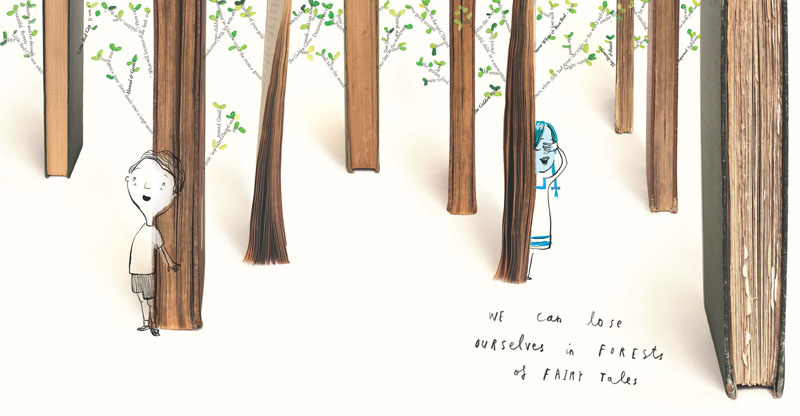
A collaboration between Jeffers and Winston is a perfect match. I have been reading and reviewing Jeffers's books for years and his love of words and stories, starting with The Incredible Book Eating Boy in 2007, is obvious. Sam Winston, a fine artist who, in Jeffers's words makes "imaginatively crafted limited edition art books," creates typographic landscapes that shine in this picture book format. Using public domain books, the endpapers for A Child of Books are a table of contents (with some extra bits worth searching out) for what can be found making up in the landscapes inside. Text from Treasure Island, Peter Pan and Wendy, Alice in Wonderland, Frankenstein and lullabies are used to creates mountains, oceans, waves, monsters, caves and trees. 
And the story itself? A meditation on imagination that follows a girl who tells readers, "I am a child of books. I come from a world of stories and upon my imagination I float." Sailing across a sea of words, she reaches a house - your house, my house - where she asks, "if you will come away with me?" A page turn is all it takes to travel over "mountains of make-believe" and through "forests of fairy tales."
A Child of Books ends with these marvelous words, "For this is our world, we're made from stories . . . Our house is a home of invention where anyone at all can come, for imagination is free."
A Child of Books is a book that you will want for yourself and to give as a gift. Stock up now, the winter holidays are just around the corner!
Source: Review Copy
It's hard to be different. Especially when you look like everyone else around you. And you wake up on the wrong side of the bed, I mean the snow. That's how Penguin Problems, written by Jory John and illustrated by Lane Smith begins. It's way too early. Way too cold. Too much squawking. Too much snow. Too bright. For our hero, the grumpy, misanthropic penguin, it's just one thing after another. The "ocean smells to salty," and buoyancy is a challenge, "I sink like a dumb rock." The indignations just don't end. Being hunted stinks. Waddling is an embarrassment.
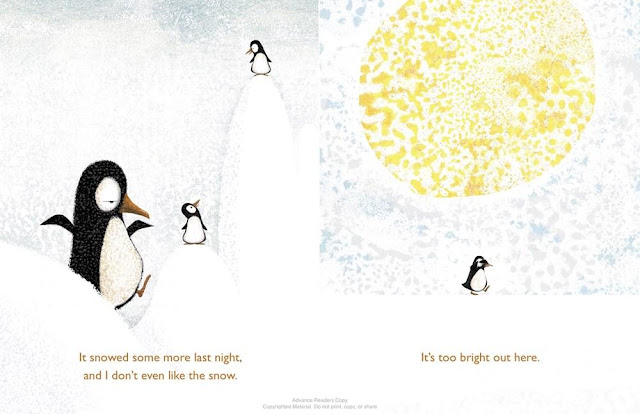
Finally, this penguin just can't take it anymore. In the midst of the snow, the ice, the crowds, he raises his little penguin fists and shouts, "I have so many problems! And nobody even cares!" For a moment, Penguin Problems shifts from picture book to novel as a walrus emerges from the tundra to show this penguin that it's not so bad, starting off with, "I sense that today as been difficult, but lo! Look around you, Penguin." The walrus urges the penguin to notice the beauty all around, to simply stand "with your penguin brothers and sisters and elders, who adore you." Yes, things are challenging and yes, we all have difficult moments, "from the walruses to the polar bears, to the whales to the penguins." But, "when you think about it, you'll realize that you are exactly where you need to be."
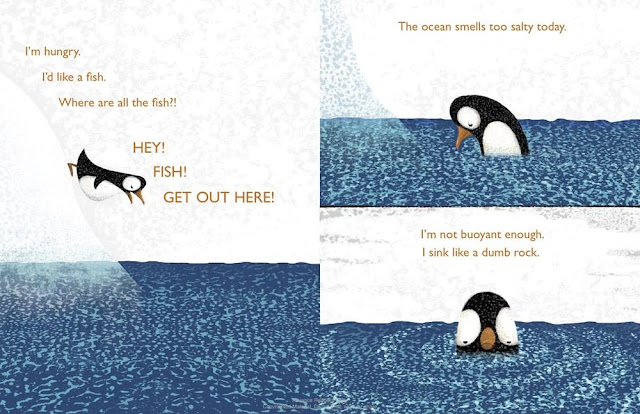
It's definitely a surprise - a good surprise - when the walrus moment arrives and goes on and on. And, just when you feel like Penguin Problems has taken a turn into the world of sentimental ly sweet picture books, a page turn takes us back to the cranky penguin, who is shrieking, "Who the heck was that guy?! Why do strangers always talk to me? Walruses don't understand penguin problems!" But, with a sigh, the penguin does gradually allow the wisdom of the walrus to sink in...
Source: Review Copy

If you have read Iggy Peck, Architect and Rosie Revere, Engineer by Andrea Beaty and David Roberts, then you already know, even without having read it, how marvelous Ada Twist, Scientist is. If you haven't read what I have come to refer to as the STEM trilogy (seriously, these books have SO MUCH teaching potential...) read any or all, and in any order you like. Each book focuses on a creative, curious child driven by a passion, be it building, inventing or asking questions about the world around her and answering her own "whys." And, in each book, our hero faces a challenge, experiences failure, rejection and being misunderstood. This trilogy is almost as much about creativity and expression of creativity as it is accepting and appreciating this passion in a person, which I adore. And these layers are what make Beaty and Roberts's books so easily embraceable and universal. Even if we are not all architects, inventors and scientists, we all have a little bit of these qualities in us and we all value (and want our kids to experience and value) the joy of expression, creation and having a passion. 

 Oh yeah, and did I mention that Beaty writes the STEM trilogy in absolutely perfect rhyme? Beaty, who also writes novels for kids (Attack of the Fluffy Bunnies, Cicada Summer) is a master rhymer - there are never any bumps or head-shakes that happen as you read her books out loud. They FLOW... And, while I do love, love, love Iggy, it's hard not to be super excited about the girl power inherent in Rosie Revere, Engineer (yes, an elderly, pear shaped Rosie the Riveter is a character in the book) and Ada Twist, Scientist, which makes nods to Ada Lovelace and Marie Curie. These books must be read many times and very closely, as Roberts tucks all sorts of nods in his marvelous illustrations, from the titles of books to the furniture and fashions.
Oh yeah, and did I mention that Beaty writes the STEM trilogy in absolutely perfect rhyme? Beaty, who also writes novels for kids (Attack of the Fluffy Bunnies, Cicada Summer) is a master rhymer - there are never any bumps or head-shakes that happen as you read her books out loud. They FLOW... And, while I do love, love, love Iggy, it's hard not to be super excited about the girl power inherent in Rosie Revere, Engineer (yes, an elderly, pear shaped Rosie the Riveter is a character in the book) and Ada Twist, Scientist, which makes nods to Ada Lovelace and Marie Curie. These books must be read many times and very closely, as Roberts tucks all sorts of nods in his marvelous illustrations, from the titles of books to the furniture and fashions.

Ada Marie Twist doesn't talk until she is three, but once she figures how to break out of her crib, she is on a "fact finding spree." Her parents have a hard time keeping up with "their high-flying kid, whose questions and chaos both grew as she did." As she grows older, Ada comes to relish the moment when a question takes shape in her mind, this just happens to be the least messy and chaotic part of the process. Happily, her parents also come to terms with the messy and chaotic parts of the process.
I hope that you will purchase any and all of the books in this trilogy for the little people in your life. From the characters and their stories to the rhymes to the magnificent illustrations, these books are about joy - about joy and the qualities that make us human and make life worthwhile - creating, exploring and sharing.
And how cool is this??? A journal! With graph paper pages!
Source: Review Copy
View Next 25 Posts


.jpeg)

